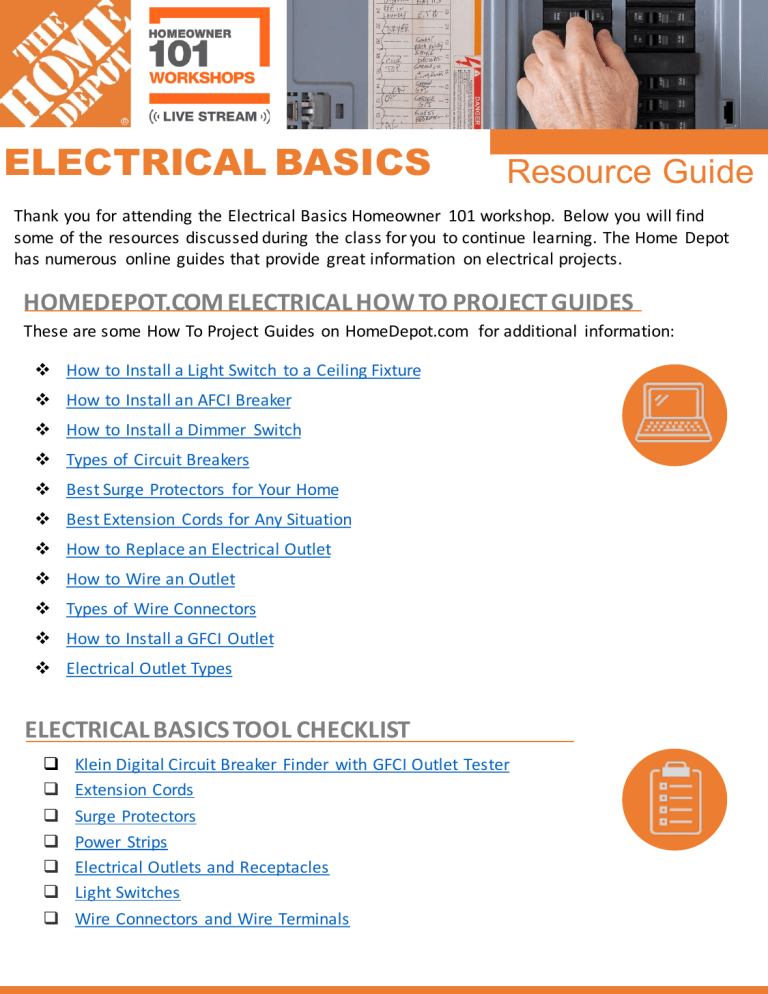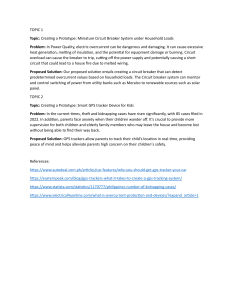Uploaded by
dimitri.bottelbergs
Electrical Basics Resource Guide: Home Wiring & Safety
advertisement

ELECTRICAL BASICS Resource Guide Thank you for attending the Electrical Basics Homeowner 101 workshop. Below you will find some of the resources discussed during the class for you to continue learning. The Home Depot has numerous online guides that provide great information on electrical projects. HOMEDEPOT.COM ELECTRICAL HOW TO PROJECT GUIDES These are some How To Project Guides on HomeDepot.com for additional information: ❖ How to Install a Light Switch to a Ceiling Fixture ❖ How to Install an AFCI Breaker ❖ How to Install a Dimmer Switch ❖ Types of Circuit Breakers ❖ Best Surge Protectors for Your Home ❖ Best Extension Cords for Any Situation ❖ How to Replace an Electrical Outlet ❖ How to Wire an Outlet ❖ Types of Wire Connectors ❖ How to Install a GFCI Outlet ❖ Electrical Outlet Types ELECTRICAL BASICS TOOL CHECKLIST ❑ ❑ ❑ ❑ ❑ ❑ ❑ Klein Digital Circuit Breaker Finder with GFCI Outlet Tester Extension Cords Surge Protectors Power Strips Electrical Outlets and Receptacles Light Switches Wire Connectors and Wire Terminals THE HOME DEPOT RENTAL ❖ Vehicle Rental ❖ Large Equipment & Tool Rental ELECTRICAL BASICS Safety—If you have any doubts about completing a project safely, work with a licensed professional. The Home Depot Home Services team can easily set you up with a professional to work with on your project. Source to Receptacle—Below is the flow of electricity to your home: • Power is delivered to your home and comes through the meter first to measure the amount of power that passes through. • From the meter, the power is delivered to the breaker box, or panel. The breaker box divides the power into smaller amounts of usable electricity and is delivered throughout your home with Romex, or wire. • Each breaker, and the Romex coming from it, create circuits. • Each circuit is rated for a specific amount of electricity measured in amps, based on the breaker and the Romex used in the circuit. • Each switch acts as a circuit breaker for a specific outlet or fixture. Protection—Below are ways your home is protected from electrical problems: • GFCI stands for ground fault circuit interrupter and trips the circuit when it detects irregular operation. These are primarily located in kitchens and bathrooms, and anywhere water can meet a receptacle. • AFCI stands for arc fault circuit interrupter and trips when the circuit heats up to prevent fires, not just electrical shocks. • Surge protectors prevent surges of electricity from passing through to outlets and fixtures. Here are the two most common types: • Power strips • Whole home surge protectors • Extension cords come in different gauges and are rated to handle different amounts of power. The lower the gauge, the thicker the cord and the more power it can safely handle. PATH TO PRO Did you find today's project interesting? If so, a career in the skilled trades might be right for you! Check out Home Depot's Path to Pro program, where you can find out more about opportunities in the skilled trades. Whether you’re looking for your first job or exploring new opportunities, Path to Pro has you covered. Visit PathtoPro.com to learn more. HOME SERVICES Need help completing a large project in your home? Discover how we can help with your next project through our Home Services. Let us do it for you. Learn more at https://www.homedepot.com/services




